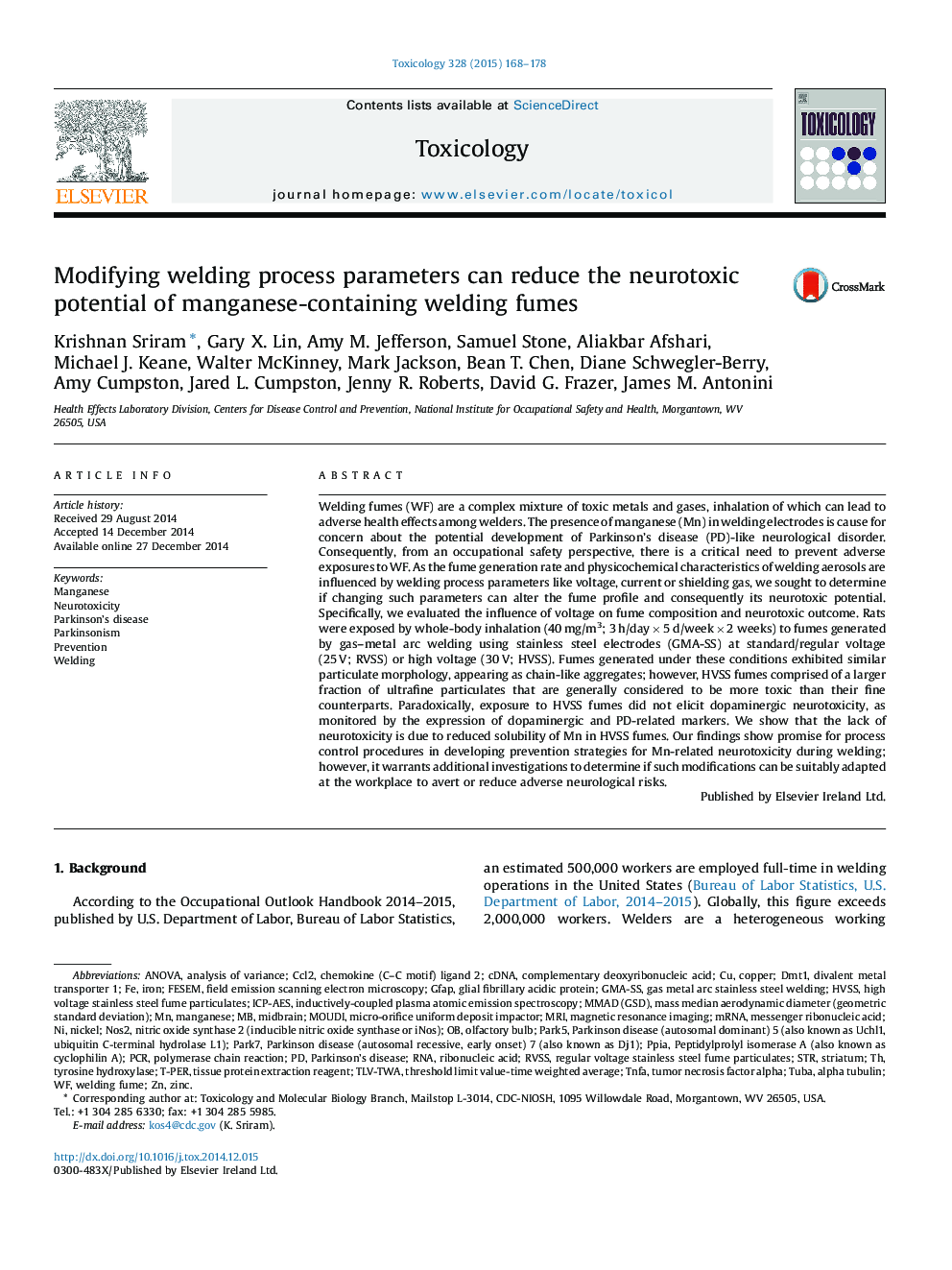| کد مقاله | کد نشریه | سال انتشار | مقاله انگلیسی | نسخه تمام متن |
|---|---|---|---|---|
| 5859131 | 1562328 | 2015 | 11 صفحه PDF | دانلود رایگان |
عنوان انگلیسی مقاله ISI
Modifying welding process parameters can reduce the neurotoxic potential of manganese-containing welding fumes
ترجمه فارسی عنوان
تغییر پارامترهای فرآیند جوشکاری می تواند پتانسیل عصبی توده های جوش داده شده منگنز را کاهش دهد
دانلود مقاله + سفارش ترجمه
دانلود مقاله ISI انگلیسی
رایگان برای ایرانیان
کلمات کلیدی
Tissue Protein Extraction ReagentT-PERPARK7GFAPTNFaPPIACCL2NOS2mRNADMT1STRICP-AESFESEMcDNA - cDNAIron - آهنStriatum - استریاتومcomplementary deoxyribonucleic acid - اسید دز اکسید ریبونوکلئیک مکملribonucleic acid - اسید ریبونوکلئیکRNA - اسید ریبونوکلئیکMRI - امآرآی یا تصویرسازی تشدید مغناطیسیParkinson’s disease - بیماری پارکینسونanalysis of variance - تحلیل واریانسANOVA - تحلیل واریانس Analysis of varianceMagnetic resonance imaging - تصویربرداری رزونانس مغناطیسیTuba - توباtumor necrosis factor alpha - تومور نکروز عامل آلفاtyrosine hydroxylase - تیروزین هیدروکسیلازWelding fume - جوش جوشWelding - جوشکاریmessenger ribonucleic acid - رسوب ریبونوکلئیک اسیدNeurotoxicity - سمیت عصبیZinc - فلز رویDivalent metal transporter 1 - متال فلچر 1Copper - مسManganese - منگنز MOUDI - موودیMidbrain - میانمغز، مزانسفالField emission scanning electron microscopy - میکروسکوپ الکترونی منتشر کننده انتشار میدانNickel - نیکلpolymerase chain reaction - واکنش زنجیره ای پلیمرازPCR - واکنش زنجیرهٔ پلیمرازParkinsonism - پارکینسونیسمGlial fibrillary acidic protein - پروتئین اسیدی فیبریلاسیون گلایالolfactory bulb - پیاز بویاییPrevention - پیشگیریchemokine (C–C motif) ligand 2 - کیموکین (C-C motif) لیگاند 2
موضوعات مرتبط
علوم زیستی و بیوفناوری
علوم محیط زیست
بهداشت، سم شناسی و جهش زایی
چکیده انگلیسی
Welding fumes (WF) are a complex mixture of toxic metals and gases, inhalation of which can lead to adverse health effects among welders. The presence of manganese (Mn) in welding electrodes is cause for concern about the potential development of Parkinson's disease (PD)-like neurological disorder. Consequently, from an occupational safety perspective, there is a critical need to prevent adverse exposures to WF. As the fume generation rate and physicochemical characteristics of welding aerosols are influenced by welding process parameters like voltage, current or shielding gas, we sought to determine if changing such parameters can alter the fume profile and consequently its neurotoxic potential. Specifically, we evaluated the influence of voltage on fume composition and neurotoxic outcome. Rats were exposed by whole-body inhalation (40 mg/m3; 3 h/day Ã 5 d/week Ã 2 weeks) to fumes generated by gas-metal arc welding using stainless steel electrodes (GMA-SS) at standard/regular voltage (25 V; RVSS) or high voltage (30 V; HVSS). Fumes generated under these conditions exhibited similar particulate morphology, appearing as chain-like aggregates; however, HVSS fumes comprised of a larger fraction of ultrafine particulates that are generally considered to be more toxic than their fine counterparts. Paradoxically, exposure to HVSS fumes did not elicit dopaminergic neurotoxicity, as monitored by the expression of dopaminergic and PD-related markers. We show that the lack of neurotoxicity is due to reduced solubility of Mn in HVSS fumes. Our findings show promise for process control procedures in developing prevention strategies for Mn-related neurotoxicity during welding; however, it warrants additional investigations to determine if such modifications can be suitably adapted at the workplace to avert or reduce adverse neurological risks.
ناشر
Database: Elsevier - ScienceDirect (ساینس دایرکت)
Journal: Toxicology - Volume 328, 3 February 2015, Pages 168-178
Journal: Toxicology - Volume 328, 3 February 2015, Pages 168-178
نویسندگان
Krishnan Sriram, Gary X. Lin, Amy M. Jefferson, Samuel Stone, Aliakbar Afshari, Michael J. Keane, Walter McKinney, Mark Jackson, Bean T. Chen, Diane Schwegler-Berry, Amy Cumpston, Jared L. Cumpston, Jenny R. Roberts, David G. Frazer, James M. Antonini,
